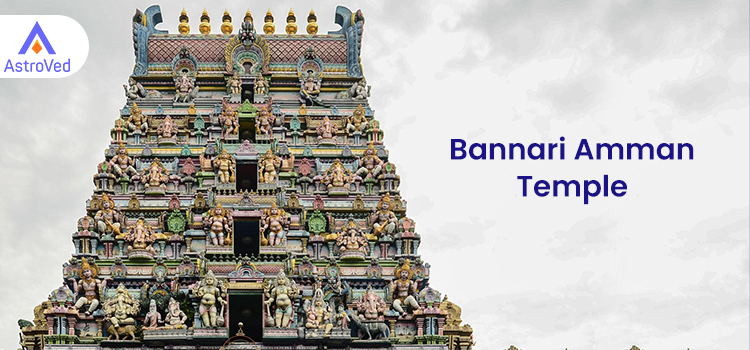Bannari Mariamman Temple is dedicated to Mariamman, the goddess of rain and an incarnation of Goddess Shakti. The deity here is Swayambhu (self-manifested). The temple is 14 km from Satyamangalam in Erode district and is on the way to Mysuru. It lies at the bottom of the Western Ghats. Mariamman is a powerful goddess in Tamil and Kannada folklore. Many villages in the Kongu belt of Tamil Nadu have a Mariamman temple.
Legend of Bannari Amman Temple
According to legend, around 300 years ago, this place used to be a dense forest where the villagers would bring their cattle and goats to graze. One day, a cowherd noticed one of the cows wandering away from the herd. When he followed it, he saw the cow releasing its milk on some Kanangu bushes growing beneath a Vengai (Indian kino) tree. The cowherd informed the villagers, who came to the spot and began to clear the undergrowth around it. While engaged thus, they found an anthill surrounded by Kanangu plants and an idol near it, under the Vengai tree. Suddenly, a person in the crowd became possessed by the deity who declared that she had accompanied some people from Kerala who were on their way to Mysore with their herds of cattle to protect them during the journey. She added that she had chosen to stay in that place as she found it very idyllic. She also asked the villagers to worship her as Bannari Amman. So, the villagers built a small structure here and began to worship the goddess. As her fame spread, a pucca structure eventually appeared, and the temple began attracting devotees from far and wide.
Another story says that, during the British rule, the villagers wanted to build a temple here. However, the person in charge denied permission. Soon after this, he fell sick. Following this, he allowed the cutting of trees so that the villagers could celebrate the festival in the temple. He also recovered after receiving the holy water from the temple and asked for the deity’s forgiveness.
Devotees offer replicas of body parts like hands, legs, and eyes, which they drop into the hundi after the Archanai. This can supposedly heal any defects related to these body parts.
History of Bannari Amman Temple
The history of the temple goes back to the 16th century. The deity came in a cart from Mannarkkadu or Vannarkkadu, the chain of Western Ghats near Palakkad in Kerala. The area was then ruled by Madurai Nayakkar. People believed that the goddess would protect the people of Mysore-Kollegal from all evils. Thus, she got the name Bannari Amman. The notorious poacher, bandit, and sandalwood smuggler Veerappan used to frequent this temple in disguise, and he had the goddess’ protection, which enabled him to elude the authorities who were seeking him many times.
Long ago, the state of Tamil Nadu had five divisions: Chera Nadu, Chola Nadu, Pandya Nadu, Thondai Nadu, and Kongu Nadu. Kongu Nadu lies in the west. The land here is very fertile, and mountains, rivers, and forests add to its charm. Bannari is on the northwestern border of Kongu Nadu. Today, devotees from all parts of south India visit this place due to the fame of the temple.
The Shobhana Mandapam in front of the temple came up in 1967 and has 24 pillars. The Artha Mandapam, the Maha Mandapam, and the Shobhana Mandapam give the temple a grand appearance.
There are also shrines here for deities like Ganesha, Bommairayan, Madeshwara Sarugu Mariamman, and Muniyappa. The Bommarayan Temple is on the Artha Mandapam’s west side, while the Ganesh Temple is on the east. Goddess Mateshwaran was installed on a slab on the temple’s south side. Near the pond, a small west-facing temple came up for Sarugu Mariamman.
Bannari Mariamman temple faces the south direction. It is in a dense forest. The vegetation grows in 3 directions – west, north, and south. Mountains and hills are part of the scenic landscape.
Once, this place had only trees and plants growing here. Then, the villagers built a structure using the Kanangu plant. Later, they built a tiled roof. The structure was renovated several times using the available funds. Now, there is a sanctuary with a dome on top.
A pit built on the temple’s west side is of use in storing water during the monsoon season.
On the left side of the temple, one can see Lord Vandimuniyappar. He was a major deity for the Cholas, who worshipped him here.
Festivals of Bannari Amman Temple
The Kundam festival is the most famous here, and it takes place in the Tamil month of Panguni (March-April). It is a 20-day festival. More than 5 lakh devotees gather here to take part in the festival. It is essentially a fire walking (walking on embers) ritual that is held every year on the last Tuesday of Maasi month. Devotees perform the ritual to fulfill their vows. The temple is decorated grandly for the occasion. Tuesdays, Fridays, and Amavasya (New Moon days) also see huge crowds. Pongal, Diwali, and New Year (Tamil and English) are celebrated here as well.
Other festivals include the Golden Chariot Festival, Murupooja Festival, and Thiruvilakku Pooja. In this temple, devotees do not receive holy ash. The sand from the anthill is offered as the Prasad instead.
Benefits of Worshipping in this Temple
Bannari Amman is regarded as a powerful goddess who can perform miracles in her devotees’ lives.
People worship the goddess to recover from eye problems.
Those who suffer from diseases like chicken pox can get relief by worshipping here. They are given neem leaves at the temple, which can supposedly heal them quickly.
One can be blessed with progeny by worshipping the goddess.
It can remove delays in marriage.
It can benefit those who need a good job.
It can bring growth and profits in business.
It can heal people who suffer from problems related to the hands and legs.
How to Reach?
By Air
The nearest airport is Coimbatore, about 57 km away. Flights are available from cities like Tirupati, Bangalore, Calicut, Cochin, etc., to Coimbatore. One can get a cab from the airport to the Temple.
By Rail
The nearest train stations are Mettupalayam, which is 45 km, and Karaimadai, which is 47 km away.
By Road
Satyamangalam, about 13 km from the temple, is the nearest.
Bannari Amman Temple Timings
The temple opens at 5 am and closes at 9 pm.


